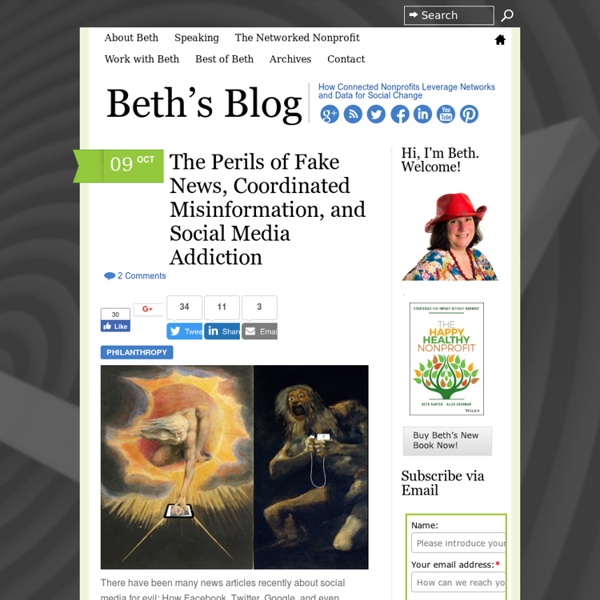Non-profit technology
Nonprofit technology is the deliberative use of technology by nonprofit organizations to maximize potential in numerous areas, primarily in supporting the organization mission and meeting reporting requirements to funders and regulators. Types of technology do not differ between nonprofit and for profit organizations. Nonprofit technology is differentiated by specific strategies and purposes. Numerous nonprofit organizations approach technology with an emphasis on cost effectiveness due to limited budgets.
Mary Meeker's speech today: Re-imagination of Content Distribution
Mary Meeker remains one of the best content curators and summarizers on the current state of the Internet. Her latest presentation delivered today in Rancho Palos Verdes, California at the D10 can be seen in full here courtesy of Business Insider. The presentationshows that Web growth remains high and that mobile adoption is still at an early stage. It also highlights current economic trends in the United States and indicates that there are seriously mixed results in monetizing mobile web use. We thought slide #20 was very interesting showing how terrible average revenue per user is for mobile users compared to desktop ones.
Is social media writing the new first rough draft of history? « museum geek
During recent weeks, I’ve felt somewhat suffocated by the media and social media coverage of events like Sandy Hook. I’m normally a news junkie, but lately I’m struggling to cope with the onslaught of information, of bitsy and incomplete pieces of coverage and comment across every platform I use. This is probably no great surprise – public interest in Newtown coverage exceeds all mass shootings since Columbine, so there has been a lot of it. But I think the mass of live-time comment like this has really brought home to me just how much open publishing platforms are really shifting the way we communicate about significant news events. After all, there is no mediation with social media.
Information and communication technologies for development
Information and Communication Technologies for Development (ICT4D) refers to the use of Information and Communication Technologies (ICTs) in the fields of socioeconomic development, international development and human rights. The theory behind this is that more and better information and communication furthers the development of a society. Aside from its reliance on technology, ICT4D also requires an understanding of community development, poverty, agriculture, healthcare, and basic education. This makes ICT4D appropriate technology and if it is shared openly open source appropriate technology.[1] Richard Heeks suggests that the I in ICT4D is related with “library and information sciences”, the C is associated with “communication studies", the T is linked with “information systems", and the D for “development studies”.[2] It is aimed at bridging the digital divide and aid economic development by fostering equitable access to modern communications technologies. History[edit]
A Few Good Pinterest Tools, Tips, and Resources
Back in January, I wrote a post about Pinterest as a curation tool to organize and share visual content I’ve collected in a pleasing visual way. As the platform has evolved over the past few months, there are some other benefits including driving traffic and conversions and more recently how pinning helps encourage audiences to “like” the brand more. I’ve be facilitating a few introductory workshops and briefings about Pinterest for nonprofits with a goal of explaining it, what it does, benefits, and examples of how nonprofits and others are using it.
GLAM
Galleries • Libraries • Archives • Museums Email the team: glam wikimedia.org The GLAM-WIKI project supports GLAMs and other institutions who want to work with Wikimedia to produce open-access, freely-reusable content for the public. Different GLAMs have different needs and goals for their projects. From our existing partnerships, we have compiled a number of model projects, and we have documented case studies on how they work in practice.
GPS bracelet uses social media to protect Civil Rights Activists
The Civil Rights Defenders have issued their first batch of GPS bracelets that will alert the CRDs' headquarters, other nearby activists, and the entirety of the CRDs' social media following if the bracelet's owner is ever kidnapped. The first 5 bracelets were issued from April 2nd through April 5th during the Civil Rights Defenders' conference, Defenders' Days. The CRD plans on issuing 55 of these bracelets over the next year and a half. The bracelets are described as a personal alarm, and the product is called the "Natalia Project". It was named after Natalia Estemirova, a human rights defender who, in 2009, was murdered within 24 hours of being kidnapped. The CRD believed that if the authorities were alerted sooner of Natalia's kidnapping, the tragedy could have been prevented.
Curator
Curator responsibilities[edit] In smaller organizations, a curator may have sole responsibility for the acquisition and care of objects. The curator will make decisions regarding what objects to take, oversee their potential and documentations, conduct research based on the collection and history that provides proper packaging of art for transportation, and shares that research with the public and community through exhibitions and publications.



